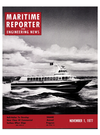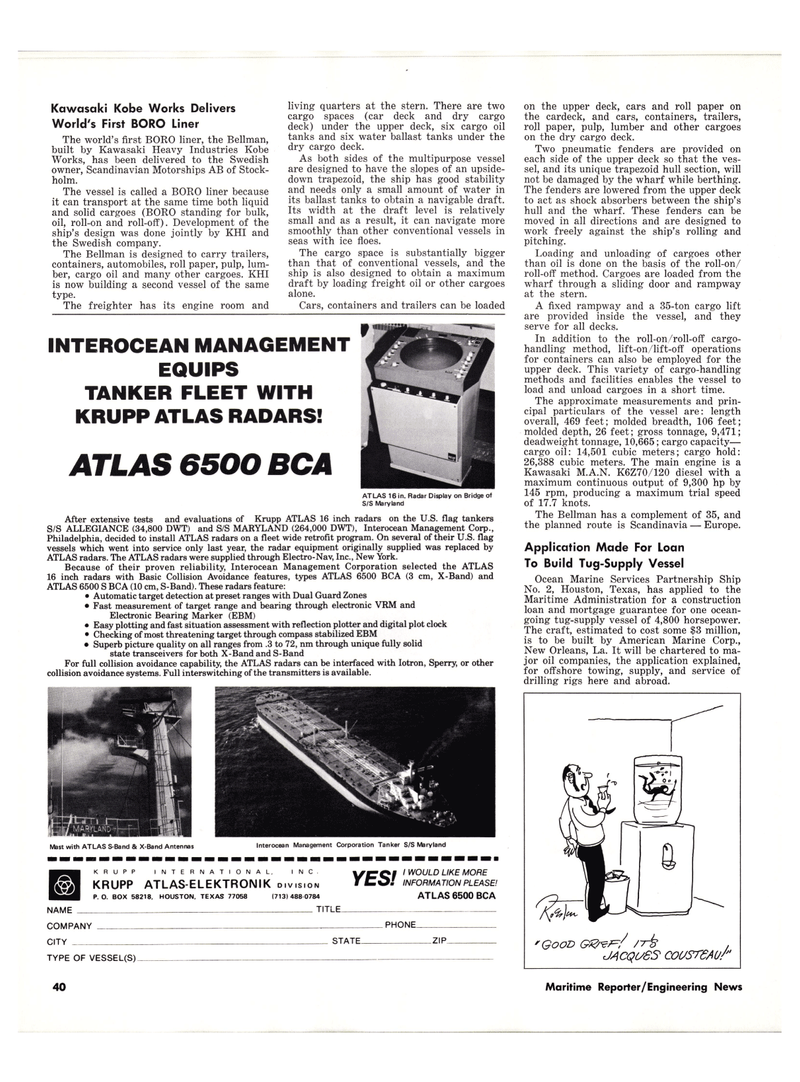
Page 38: of Maritime Reporter Magazine (November 1977)
Read this page in Pdf, Flash or Html5 edition of November 1977 Maritime Reporter Magazine
Kawasaki Kobe Works Delivers
World's First BORO Liner
The world's first BORO liner, the Bellman, built by Kawasaki Heavy Industries Kobe
Works, has been delivered to the Swedish owner, Scandinavian Motorships AB of Stock- holm.
The vessel is called a BORO liner because it can transport at the same time both liquid and solid cargoes (BORO standing for bulk, oil, roll-on and roll-off). Development of the ship's design was done jointly by KHI and the Swedish company.
The Bellman is designed to carry trailers, containers, automobiles, roll paper, pulp, lum- ber, cargo oil and many other cargoes. KHI is now building a second vessel of the same type.
The freighter has its engine room and living quarters at the stern. There are two cargo spaces (car deck and dry cargo deck) under the upper deck, six cargo oil tanks and six water ballast tanks under the dry cargo deck.
As both sides of the multipurpose vessel are designed to have the slopes of an upside- down trapezoid, the ship has good stability and needs only a small amount of water in its ballast tanks to obtain a navigable draft.
Its width at the draft level is relatively small and as a result, it can navigate more smoothly than other conventional vessels in seas with ice floes.
The cargo space is substantially bigger than that of conventional vessels, and the ship is also designed to obtain a maximum draft by loading freight oil or other cargoes alone.
Cars, containers and trailers can be loaded
ATLAS 16 in. Radar Display on Bridge of
S/S Maryland on the upper deck, cars and roll paper on the cardeck, and cars, containers, trailers, roll paper, pulp, lumber and other cargoes on the dry cargo deck.
Two pneumatic fenders are provided on each side of the upper deck so that the ves- sel, and its unique trapezoid hull section, will not be damaged by the wharf while berthing.
The fenders are lowered from the upper deck to act as shock absorbers between the ship's hull and the wharf. These fenders can be moved in all directions and are designed to work freely against the ship's rolling and pitching.
Loading and unloading of cargoes other than oil is done on the basis of the roll-on/ roll-off method. Cargoes are loaded from the wharf through a sliding door and rampway at the stern.
A fixed rampway and a 35-ton cargo lift are provided inside the vessel, and they serve for all decks.
In addition to the roll-on/roll-off cargo- handling method, lift-on/lift-off operations for containers can also be employed for the upper deck. This variety of cargo-handling methods and facilities enables the vessel to load and unload cargoes in a short time.
The approximate measurements and prin- cipal particulars of the vessel are: length overall, 469 feet; molded breadth, 106 feet; molded depth, 26 feet; gross tonnage, 9,471; deadweight tonnage, 10,665; cargo capacity— cargo oil: 14,501 cubic meters; cargo hold: 26,388 cubic meters. The main engine is a
Kawasaki M.A.N. K6Z70/120 diesel with a maximum continuous output of 9,300 hp by 145 rpm, producing a maximum trial speed of 17.7 knots.
The Bellman has a complement of 35, and the planned route is Scandinavia — Europe.
Application Made For Loan
To Build Tug-Supply Vessel
Ocean Marine Services Partnership Ship
No. 2, Houston, Texas, has applied to the
Maritime Administration for a construction loan and mortgage guarantee for one ocean- going tug-supply vessel of 4,800 horsepower.
The craft, estimated to cost some $3 million, is to be built by American Marine Corp.,
New Orleans, La. It will be chartered to ma- jor oil companies, the application explained, for offshore towing, supply, and service of drilling rigs here and abroad.
INTEROCEAN MANAGEMENT
EQUIPS
TANKER FLEET WITH
KRUPP ATLAS RADARS!
ATLAS 6500 BCA
After extensive tests and evaluations of Krupp ATLAS 16 inch radars on the U.S. flag tankers
S/S ALLEGIANCE (34,800 DWT) and S/S MARYLAND (264,000 DWT), Interocean Management Corp.,
Philadelphia, decided to install ATLAS radars on a fleet wide retrofit program. On several of their U.S. flag vessels which went into service only last year, the radar equipment originally supplied was replaced by
ATLAS radars. The ATLAS radars were supplied through Electro-Nav, Inc., New York.
Because of their proven reliability, Interocean Management Corporation selected the ATLAS 16 inch radars with Basic Collision Avoidance features, types ATLAS 6500 BCA (3 cm, X-Band) and
ATLAS 6500 S BCA (10 cm, S-Band). These radars feature: • Automatic target detection at preset ranges with Dual Guard Zones • Fast measurement of target range and bearing through electronic VRM and
Electronic Bearing Marker (EBM) • Easy plotting and fast situation assessment with reflection plotter and digital plot clock • Checking of most threatening target through compass stabilized EBM • Superb picture quality on all ranges from .3 to 72, nm through unique fully solid state transceivers for both X-Band and S-Band
For full collision avoidance capability, the ATLAS radars can be interfaced with Iotron, Sperry, or other collision avoidance systems. Full interswitching of the transmitters is available.
Mast with ATLAS S-Band & X-Band Antennas Interocean Management Corporation Tanker S/S Maryland tm mm mm m •• •• mm mm Mi hi mm mm im •• mt mm mm mm m m mm ^m mm ^m mm mm mm m •• mm mm m mm ih •
KRUPP INTERNATIONAL, INC 1/CQf 1 WOULD LIKE MORE pSg KRUPP ATLAS-ELEKTRONIK DIVISION Y tZO! INFORMATION PLEASE:
MAM P. 0. BOX 58218. HOUSTON. TEXAS 77058 (713)488 0784 ATLAS 6500 BCA
NAME TITLE
COMPANY PHONE
CITY STATE ZIP
TYPE OF VESSEL(S) 40 ''GOOD , JAcqc/ss cousreAur
Maritime Reporter/Engineering • News

 37
37

 39
39
